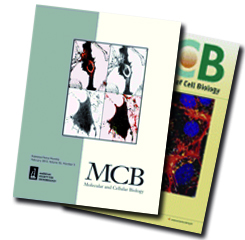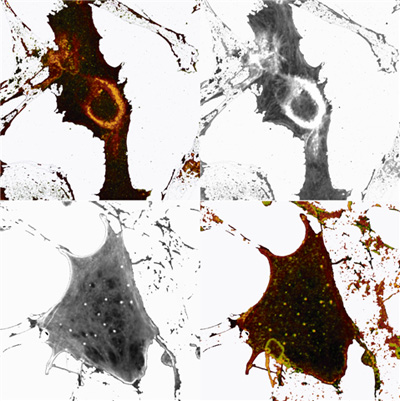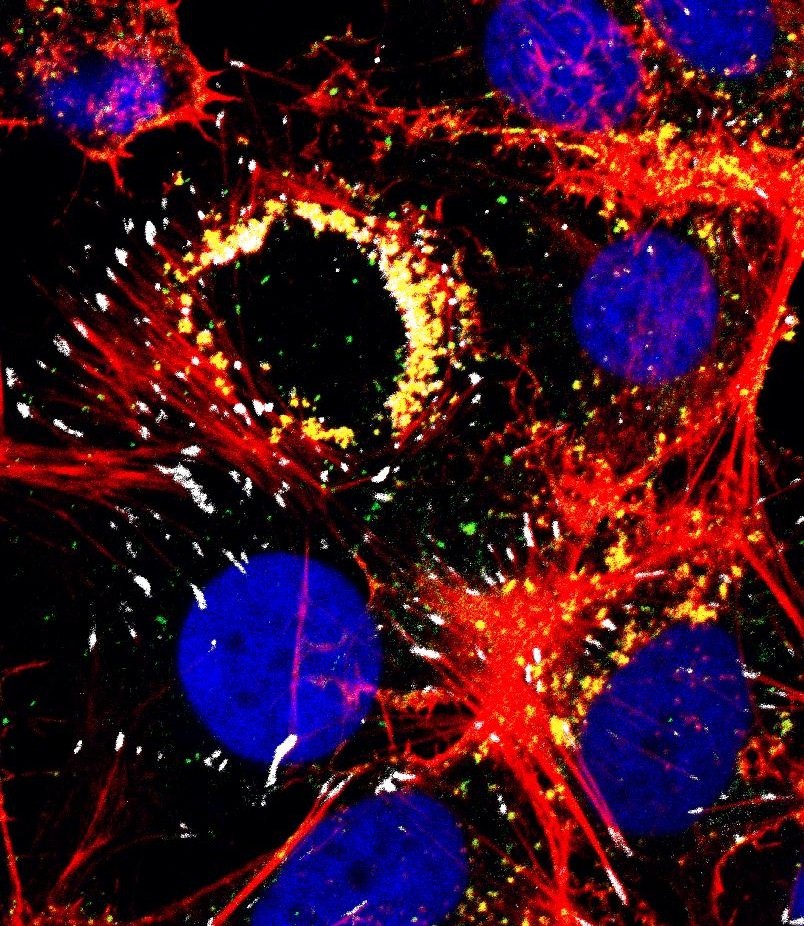| 2 covers on podosomes in a row! |

Two covers on podosomes in a row! In February and March 2012, the journal Molecular and Cellular Biology and the European journal Cell Biology took pictures from her recent articles to illustrate their cover.
Podosome formation: A new piece of the jigsaw Podosomes are actin microdomains which can form on the ventral membrane of certain cells. Because of their ability to degrade the extracellular matrix, they are deemed to promote cell motility and allow cell to cross anatomical boundaries. In endothelial cells – cells which cover the interior surface of our blood vessels – it has been found that the formation of podosomes is induced by the Transforming growth factor (TGF). TGF is known to play a key role in the development and maintenance of the cardio-vascular system as it controls the proliferation of endothelial cells. However, up-to-now, very little was known about the signaling cascade triggered by TGF which causes the formation of podosomes in endothelial cells. In September 2011, the Elisabeth Génot team identified a protein which links TGFto Cdc42, a molecular switch that needs to be “on” to induce the assembly of actin into podosomes. This protein, a guanine exchange factor called Fdg1, had not been previously reported in endothelial cells. Mutations in Fgd1, which are known to affect bone development in physiology, are thus expected to alter vascular homeostasis. The Génot paper, which was used to illustrate the February 2012 issue of Molecular and Cellular Biology, may reveal unexpected origins for some cardio-vascular diseases. Caption: Stimulation of bovine aortic endothelial cells with transforming growth factor induces the formation of podosome rosettes (top). Expression of a constitutively active form of the guanine exchange factor Fgd1 triggers the formations of podosome dots not assembled in rosettes (bottom). Phalloidin staining for F-actin is shown in grey. Merge staining for cortactin and F-actin highlights the podosome structures (yellow represents colocalization of the two proteins).
Infected liver cells can produce podosomes Helicobacter pylori is a bacterium that colonizes the stomach in about 50% of all humans. Well known as a key risk factor in gastric diseases, it may also damage liver, causing cirrhosis and liver cancer. The latest article of the Génot team, published in the European Journal of Cell Biology in March 2012, demonstrates that the bacterium promotes the formation of podosomes in liver cells in vitro. Indeed, infection by Helicobacter pylori of liver cells induces the release of inflammatory cytokines, including TGF, which trigger the formation of podosomes. Researchers observed that liver cells with podosomes had reduced self-healing capacities. Although it is not yet clear which role podosomes play in the response to bacterial infection, the Elisabeth Génot team believes that podosomes can also be found in vivo in liver cells infected with Helicobacter pylori and contribute to the pathological state. Caption: Hepatocellular carcinoma cells were infected with Helicobacter pylori and cells were stained for F-actin (red), cortactin (green) and vinculin (white). Nuclei of the cells are shown in blue. Infected cells assemble actin-rich circular structures called podosome rosettes that can be seen in the middle of the image. |
2, Rue Robert Escarpit - 33607 PESSAC - France
Tel. : +33 (5) 40 00 30 38 - Fax. : +33 (5) 40 00 30 68






